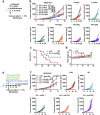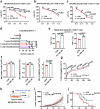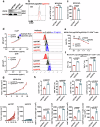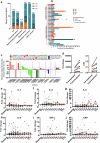Inhibition of glycosphingolipid synthesis with eliglustat in combination with immune checkpoint inhibitors in advanced cancers: preclinical evidence and phase I clinical trial
- PMID: 39138212
- PMCID: PMC11322526
- DOI: 10.1038/s41467-024-51495-3
Inhibition of glycosphingolipid synthesis with eliglustat in combination with immune checkpoint inhibitors in advanced cancers: preclinical evidence and phase I clinical trial
Abstract
Glycosphingolipids (GSLs) are abundantly expressed in cancer cells. The effects of GSL-targeted immunotherapies are not fully understood. Here, we show that the inhibition of GSL synthesis with the UDP-glucose ceramide glucosyltransferase inhibitor eliglustat can increase the exposure of the major histocompatibility complex (MHC) and tumour antigen peptides, enhancing the antitumour response of CD8+ T cells in a range of tumour models. We therefore conducted a proof-of-concept phase I trial on the combination of eliglustat and an anti-PD-1 antibody for the treatment of advanced cancers (NCT04944888). The primary endpoints were safety and feasibility, and the secondary endpoint was antitumor activity. All prespecified endpoints were met. Among the 31 enrolled patients, only 1 patient experienced a grade 3 adverse event (AE), and no grade 4 AEs were observed. The objective response rate was 22.6% and the disease control rate reached 71%. Of the 8 patients with proficient mismatch repair/microsatellite stable (pMMR/MSS) colorectal cancer, one achieved complete response and two each had partial response and stable disease. In summary, inhibiting the synthesis of GSLs might represent an effective immunotherapy approach.
© 2024. The Author(s).
Conflict of interest statement
The authors declare no competing interests.
Figures








Similar articles
-
PD-1 blockade enhances the effect of targeted chemotherapy on locally advanced pMMR/MSS colorectal cancer.Cancer Med. 2024 Jun;13(12):e7224. doi: 10.1002/cam4.7224. Cancer Med. 2024. PMID: 38888366 Free PMC article.
-
SHR-8068 combined with adebrelimab and bevacizumab in the treatment of refractory advanced colorectal cancer: study protocol for a single-arm, phase Ib/II study.Front Immunol. 2024 Oct 9;15:1450533. doi: 10.3389/fimmu.2024.1450533. eCollection 2024. Front Immunol. 2024. PMID: 39445023 Free PMC article.
-
Neoadjuvant camrelizumab plus apatinib for locally advanced microsatellite instability-high or mismatch repair-deficient colorectal cancer (NEOCAP): a single-arm, open-label, phase 2 study.Lancet Oncol. 2024 Jul;25(7):843-852. doi: 10.1016/S1470-2045(24)00203-1. Epub 2024 Jun 6. Lancet Oncol. 2024. PMID: 38852601 Clinical Trial.
-
Single or combined immune checkpoint inhibitors compared to first-line platinum-based chemotherapy with or without bevacizumab for people with advanced non-small cell lung cancer.Cochrane Database Syst Rev. 2020 Dec 14;12(12):CD013257. doi: 10.1002/14651858.CD013257.pub2. Cochrane Database Syst Rev. 2020. Update in: Cochrane Database Syst Rev. 2021 Apr 30;4:CD013257. doi: 10.1002/14651858.CD013257.pub3. PMID: 33316104 Free PMC article. Updated.
-
Single or combined immune checkpoint inhibitors compared to first-line platinum-based chemotherapy with or without bevacizumab for people with advanced non-small cell lung cancer.Cochrane Database Syst Rev. 2021 Apr 30;4(4):CD013257. doi: 10.1002/14651858.CD013257.pub3. Cochrane Database Syst Rev. 2021. PMID: 33930176 Free PMC article.
Cited by
-
Metabolomic profiling reveals interindividual metabolic variability and its association with cardiovascular-kidney-metabolic syndrome risk.Cardiovasc Diabetol. 2025 Aug 1;24(1):315. doi: 10.1186/s12933-025-02881-8. Cardiovasc Diabetol. 2025. PMID: 40751246 Free PMC article.
-
Unraveling the glyco-immunity nexus in pancreatic cancer.Mol Cancer. 2025 Aug 4;24(1):211. doi: 10.1186/s12943-025-02417-4. Mol Cancer. 2025. PMID: 40759948 Free PMC article. Review.
-
Engineering TCR-preserved allogeneic CAR-T cells: leveraging cancer immune evasion principles to establish T-cell tolerance.Cell Mol Immunol. 2025 Aug 26. doi: 10.1038/s41423-025-01341-3. Online ahead of print. Cell Mol Immunol. 2025. PMID: 40855002 No abstract available.
-
Glycosphingolipids as emerging attack points in bladder cancer.Discov Oncol. 2025 Apr 19;16(1):569. doi: 10.1007/s12672-025-02302-y. Discov Oncol. 2025. PMID: 40252176 Free PMC article. Review.
-
Glucose-dependent glycosphingolipid biosynthesis fuels CD8+ T cell function and tumor control.bioRxiv [Preprint]. 2024 Oct 14:2024.10.10.617261. doi: 10.1101/2024.10.10.617261. bioRxiv. 2024. Update in: Cell Metab. 2025 Jul 30:S1550-4131(25)00333-X. doi: 10.1016/j.cmet.2025.07.006. PMID: 39464161 Free PMC article. Updated. Preprint.
References
Publication types
MeSH terms
Substances
Grants and funding
- 82150108/National Natural Science Foundation of China (National Science Foundation of China)
- 31991171/National Natural Science Foundation of China (National Science Foundation of China)
- 82341208/National Natural Science Foundation of China (National Science Foundation of China)
- 82370226/National Natural Science Foundation of China (National Science Foundation of China)
LinkOut - more resources
Full Text Sources
Other Literature Sources
Research Materials
Miscellaneous

